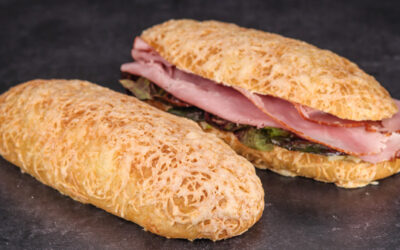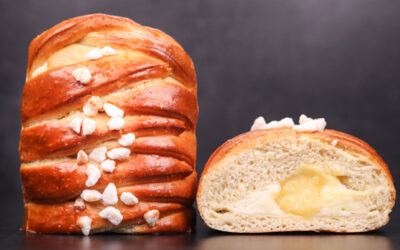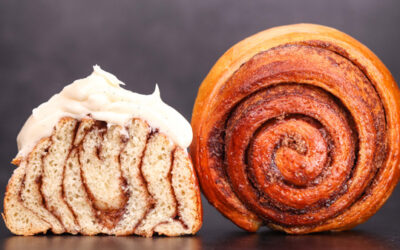The unique design of a babka is achieved by filling the dough, rolling it up, cutting in half, and finally twisting back together. The roll is made the same way that you’d make cinnamon rolls, but instead of cutting it into slices it is cut lengthways. Once sliced in half it reveals beautiful layers of dough and filling which make for a fantastic looking loaf in the end.
There are a couple of babka videos on the channel already from way back in the day when I still used to knead bread dough. I thought it’s time for an update. And while I was at it, I wanted to test how the dough would react if I added peanut butter to the mix instead of using it as a filling.
Peanut butter is pretty much 50% fat, so I based my fat percentage calculations on that number. Some extra butter was added for flavour and to increase the fat content a bit more. There is an egg yolk in the mix too which also contains fat. Even though there are a bunch of fatty ingredients in this dough, the final baker’s percentage of fat was around 20%.
The jam was quite sweet, so I opted for not adding a lot of sugar to the dough. As a result, this bread is not super rich. The peanut butter flavour comes through nicely and works well with the jam. It has a good balance of flavour.
This loaf will fit in a 2lb (900g) baking tin.
Watch the video down below for detailed instructions.
Ingredients
For the dough –
220g (7.75oz) water
6g (0.21oz) instant dry yeast or 7.2g (0.25oz) active dry yeast or 18g (0.63oz) fresh yeast
6g (0.21oz) salt
20g (0.7oz) sugar
20g (0.7o) butter
100g (3.5oz) smooth peanut butter
1 egg yolk
400g (14.1oz) white bread flour
For filling –
200g (7oz) raspberry jam or any jam that you like
To glaze –
1 egg white, which I forgot to use. Alternatively, add a whole egg to the dough and reduce the amount of water by 30g (1oz).
To learn more about no-knead bread dough temperature control click here.
The flour I use has a protein content of 13%. If your flour is weaker, then you may need to lower the hydration.
If you are using active dry yeast, then you may need to let it sit in the water for 10 minutes before adding the other ingredients or else it could take a lot longer to raise the dough.
If you are curious about why the dough contains butter, egg, and sugar, click the links to learn more about the effects those ingredients have on bread dough.
Method
- In a large bowl combine the water, yeast, salt, sugar, peanut butter, butter, and egg yolk. Mix well. Add the flour and mix to a dough. *Desired dough temperature 25C (77F). If your dough is warmer, then it will ferment more rapidly. If it is cooler, then it will take longer. Adjust fermentation time accordingly.
- Cover and ferment for 30 minutes.
- Fold.
- Ferment for 30 minutes.
- Roll the dough out to a large rectangle. Spread with jam leaving an edge at the top. Brush the edge with water. Roll the dough up and seal it. Slice the roll in half lengthways and place the two pieces side by side with the cut side facing up. Twist the two pieces together.
- Place the twisted loaf in a buttered baking tin. Cover.
- Final proof 1 – 1.5 hours.
- Bake at 160C (320F) fan on or 180C (355F) fan off for 50 minutes. If it starts becoming too dark cover it with foil for the rest of the bake.
- Leave to cool and then tuck in!
Keep in mind that the conditions in each kitchen are different, so fermentation times may vary for you. It is up to the baker to control the bread and react accordingly.
Your oven may be different too, so your baking time may vary.



